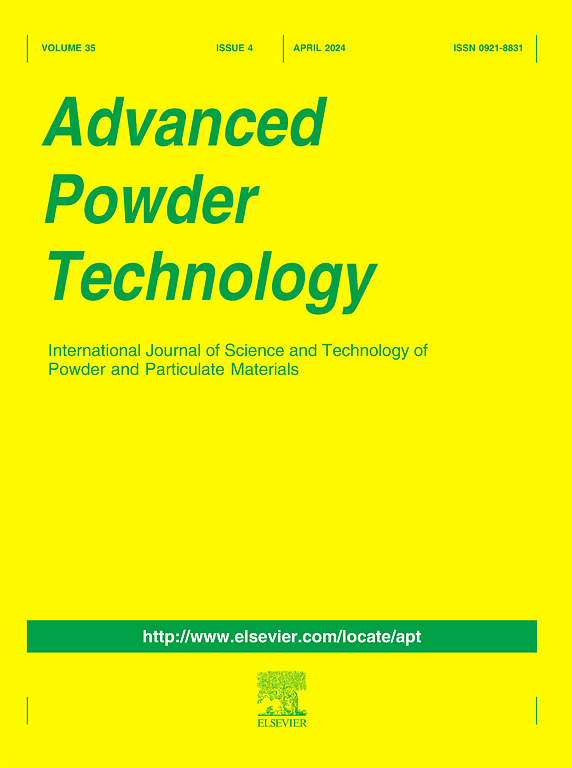局部侵蚀对旋风分离器内流型和颗粒自旋的影响
IF 4.2
2区 工程技术
Q2 ENGINEERING, CHEMICAL
引用次数: 0
摘要
冲蚀是旋风分离器不可避免的问题,严重的冲蚀会极大地影响颗粒的运动。为了提高对旋风分离器内颗粒自旋的认识,本研究利用CFD和DEM耦合模拟,探讨了局部壁面侵蚀对旋风分离器内局部涡和颗粒自旋的影响。数值结果表明,随着圆柱内侵蚀厚度的增加,颗粒自旋减小。粒子容易在锥体内聚集,这严重影响了粒子的自旋速度。当侵蚀厚度仅为2mm或5mm时,壁面的轻微变形有助于破碎颗粒团聚,从而提高颗粒自旋速度。然而,当侵蚀厚度达到10 mm或15 mm时,严重的磨损和变形产生更深的凹槽,促进颗粒聚集(颗粒自旋转速度分别比无磨损的旋风分离器降低7.2%和19.9%)。同时,较大的侵蚀厚度会产生局部涡,改变粒子的运动轨迹,使其更容易被内部准强迫涡捕获。本文章由计算机程序翻译,如有差异,请以英文原文为准。

Effect of local erosion on flow pattern and particle self-rotation in a cyclone separator
Erosion is an inevitable problem of cyclone separator, and serious erosion will greatly affect the movement of the particles. To improve the understanding of the particle self-rotation in cyclone separator, in this research, we explored the influence of local wall erosion on local vortices and particle self-rotation in cyclone separators, leveraging coupled CFD and DEM simulations. The numerical results show that as erosion thickness grows in the cylinder, particle self-rotation decreases. Particles are prone to aggregation within the cone, which significantly affects their self-rotation speed. When the erosion thickness is only 2 mm or 5 mm, the slight deformation of the wall surface helps break up particle agglomeration, thereby increasing the particle self-rotation speed. However, when the erosion thickness reaches 10 mm or 15 mm, severe wear and deformation create deeper grooves, which promote particle aggregation (the particle self-rotation speed decreases by 7.2 % and 19.9 % respectively, compared to the cyclone separator without wear). Meanwhile, the larger erosion thickness spawns local vortices that alter particle motion trajectory and make them more likely to be captured by internal quasi-forced vortex.
求助全文
通过发布文献求助,成功后即可免费获取论文全文。
去求助
来源期刊

Advanced Powder Technology
工程技术-工程:化工
CiteScore
9.50
自引率
7.70%
发文量
424
审稿时长
55 days
期刊介绍:
The aim of Advanced Powder Technology is to meet the demand for an international journal that integrates all aspects of science and technology research on powder and particulate materials. The journal fulfills this purpose by publishing original research papers, rapid communications, reviews, and translated articles by prominent researchers worldwide.
The editorial work of Advanced Powder Technology, which was founded as the International Journal of the Society of Powder Technology, Japan, is now shared by distinguished board members, who operate in a unique framework designed to respond to the increasing global demand for articles on not only powder and particles, but also on various materials produced from them.
Advanced Powder Technology covers various areas, but a discussion of powder and particles is required in articles. Topics include: Production of powder and particulate materials in gases and liquids(nanoparticles, fine ceramics, pharmaceuticals, novel functional materials, etc.); Aerosol and colloidal processing; Powder and particle characterization; Dynamics and phenomena; Calculation and simulation (CFD, DEM, Monte Carlo method, population balance, etc.); Measurement and control of powder processes; Particle modification; Comminution; Powder handling and operations (storage, transport, granulation, separation, fluidization, etc.)
 求助内容:
求助内容: 应助结果提醒方式:
应助结果提醒方式:


